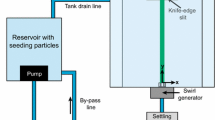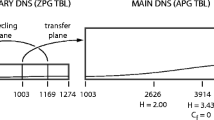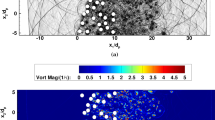In Memory of Professor Mikhail Ivanovich Nisht
Abstract
A method is suggested for simulating axisymmetric laminar or turbulent flows formed during the motion of a vortex-ring bunch of given geometry and circulation toward a plane screen. Earlier, similar problems were simulated with the numerical solution of the Navier-Stokes equations for laminar flows. Turbulent flows have remained unconsidered until now. When a vortex ring approaches the screen, the secondary nonstationary flow is induced near the screen’s surface and this secondary flow causes the formation of the radial boundary layer (provided that air viscosity is taken into account). First, the medium spreads out from the critical point at the screen’s center with the negative pressure gradient along the radial coordinate and then detaches in the region of the positive pressure gradient. This radial wall flow and the corresponding boundary layer are considered in the quasi-stationary approximation. When the boundary layer detaches at successive instances, the flow is replenished with the radially moving secondary vortex rings whose circulations have the sign opposite to that of the circulation of the primary vortex ring. It is the interaction of the primary and secondary vortices that governs process dynamics, which differs substantially from that in the case when the formation of secondary vortices is disregarded. The suggested method is based on the method of discrete vortices (a perfect liquid) and the boundary-layer (laminar or turbulent) theory. During the development of the flow under investigation, the nonstationary ascending flow in the direction perpendicular to the screen’s plane is formed and then this flow decays and dissipates. Simulations for large Reynolds numbers corresponding to the formation of the turbulent boundary layer show that the velocity of ascending vortices in the plane of the initial vortex bunch is less than one-tenth of the initial velocity of the descending vortex ring. The boundary layer is introduced into calculations with the sole goal of determining the parameters of the secondary vortex rings formed during boundary-layer detachments. The interaction of the primary and secondary vortices is then considered within the framework of a perfect medium. Simulations for large Reynolds numbers corresponding to the formation of the turbulent boundary layer on the screen were correlated with the available data obtained in laboratory experiments for small Reynolds numbers. Qualitative agreement between the simulations and experiments is fairly satisfactory. The simulation for one combination of the circulation and vortex-ring geometry takes at most 10–15 min with the use of an average PC.
Similar content being viewed by others
References
M. A. Lavrent’ev and B. V. Shabat, Hydrodynamic Problems and Their Mathematical Models (Fizmatlit, Moscow, 1973) [in Russian].
D. G. Akhmetov and B. A. Lugovtsov, “Fire Extinguishing on Gas and Oil Wells with Vortex Rings,” Fiz. Goreniya Vzryva, No. 5, 8–14 (1980).
D. G. Akhmetov and B. A. Lugovtsov, “Eddy-Powder Method of Fire Extinguishing on Gas and Oil Wells,” in Proceedings of Workshop on Oil-Stratum Physics (Novosibirsk, 2002), pp. 7–14 [in Russian].
Intense Atmospheric Vortices, Ed. by L. Bengtsson and J. Lighthill (Springer, Heidelberg, 1982; Mir, Moscow, 1985).
O. G. Goman, V. I. Karplyuk, M. I. Nisht, and A. G. Sudakov, Numerical Simulation of Axisymmetric Detached Flows of an Incompressible Fluid, Ed. by M. I. Nisht (Mahinostroenie, Moscow, 1999) [in Russian].
P. G. Saffman, Vortex Dynamics, (Cambridge Univ. Press, 1992).
A. M. Naguib and M. M. Koochessfahani, “On Wall-Pressure Sources Associated with the Unsteady Separation in a Vortex-Ring/Wall Interaction,” Phys. Fluids 16, 2613–2622 (2004).
J. D. A. Walker, C. R. Smith, A. W. Cerra, and T. L. Doligalski, “The Impact of a Vortex Ring on a Wall,” J. Fluid Mech. 181, 99–140 (1987).
A. S. Belotserkovskii and A. S. Ginevsky, “Numerical Simulation of an Aircraft Turbulent Trail for Takeoff and Landing Regimes,” Dokl. Akad. Nauk 380, 761–764 (2001).
A. S. Belotserkovskii, A. S. Ginevsky, T. V. Pogrebnaya, and S. D. Shipilov, “Modeling the Far Turbulent Trail of Mainline Aircraft During Takeoffs and Landings,” Usp. Mekh. 2(4), 106–127 (2003).
K. K. Fedyaevskii, A. S. Ginevsky, and A. V. Kolesnikov, Calculation of the Turbulent Boundary Layer of an Incompressible Fluid (Sudostroenie, Leningrad, 1973) [in Russian].
Author information
Authors and Affiliations
Additional information
Original Russian Text © A.S. Ginevsky, T.V. Pogrebnaya, S.D. Shipilov, 2006, published in Izvestiya AN, Fizika Atmosfery i Okeana, 2006, Vol. 42, No. 5, pp. 681–686.
Rights and permissions
About this article
Cite this article
Ginevsky, A.S., Pogrebnaya, T.V. & Shipilov, S.D. Inleakage of a vortex-ring bunch onto a plane screen. Izv. Atmos. Ocean. Phys. 42, 627–631 (2006). https://doi.org/10.1134/S0001433806050082
Received:
Issue Date:
DOI: https://doi.org/10.1134/S0001433806050082




